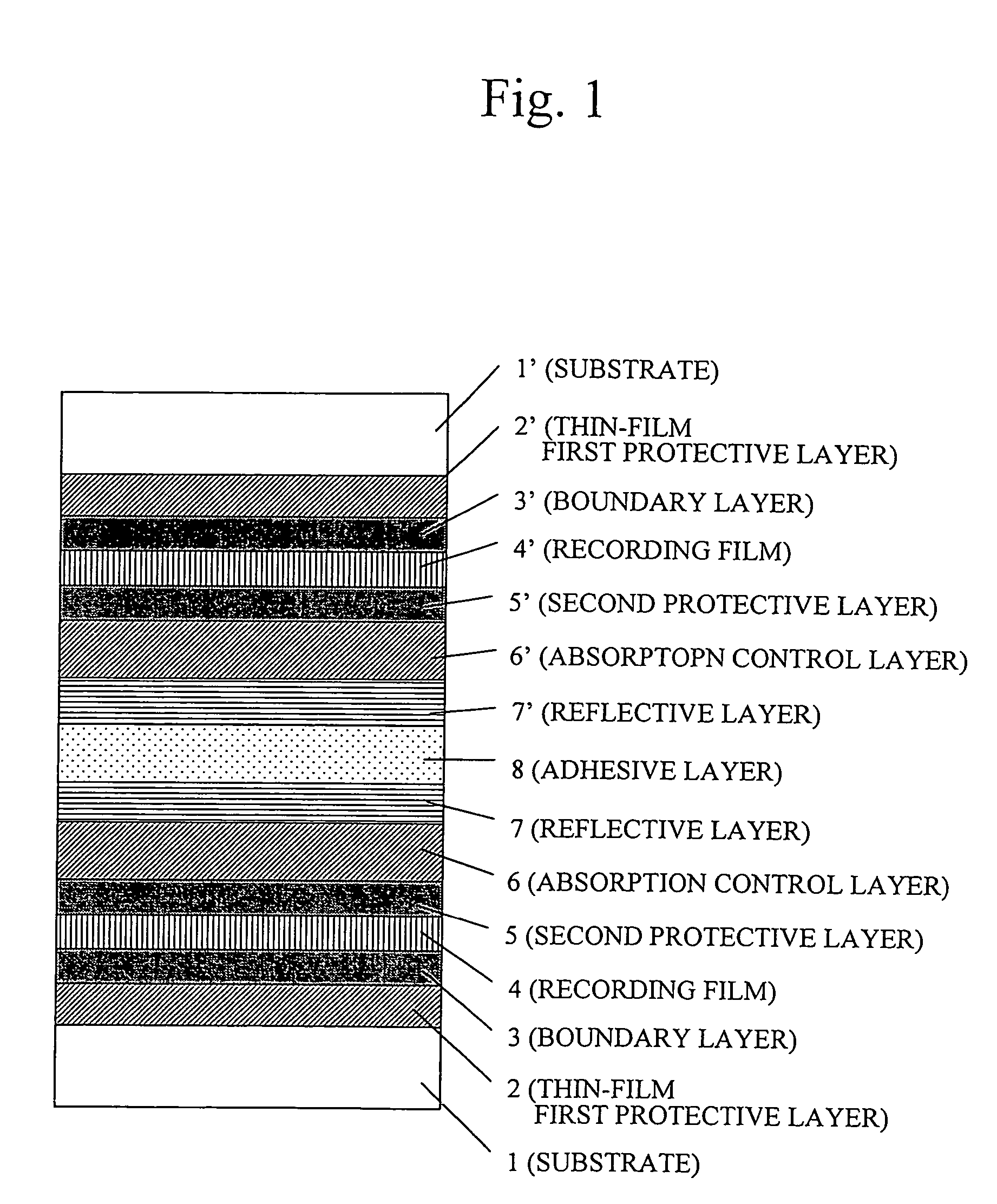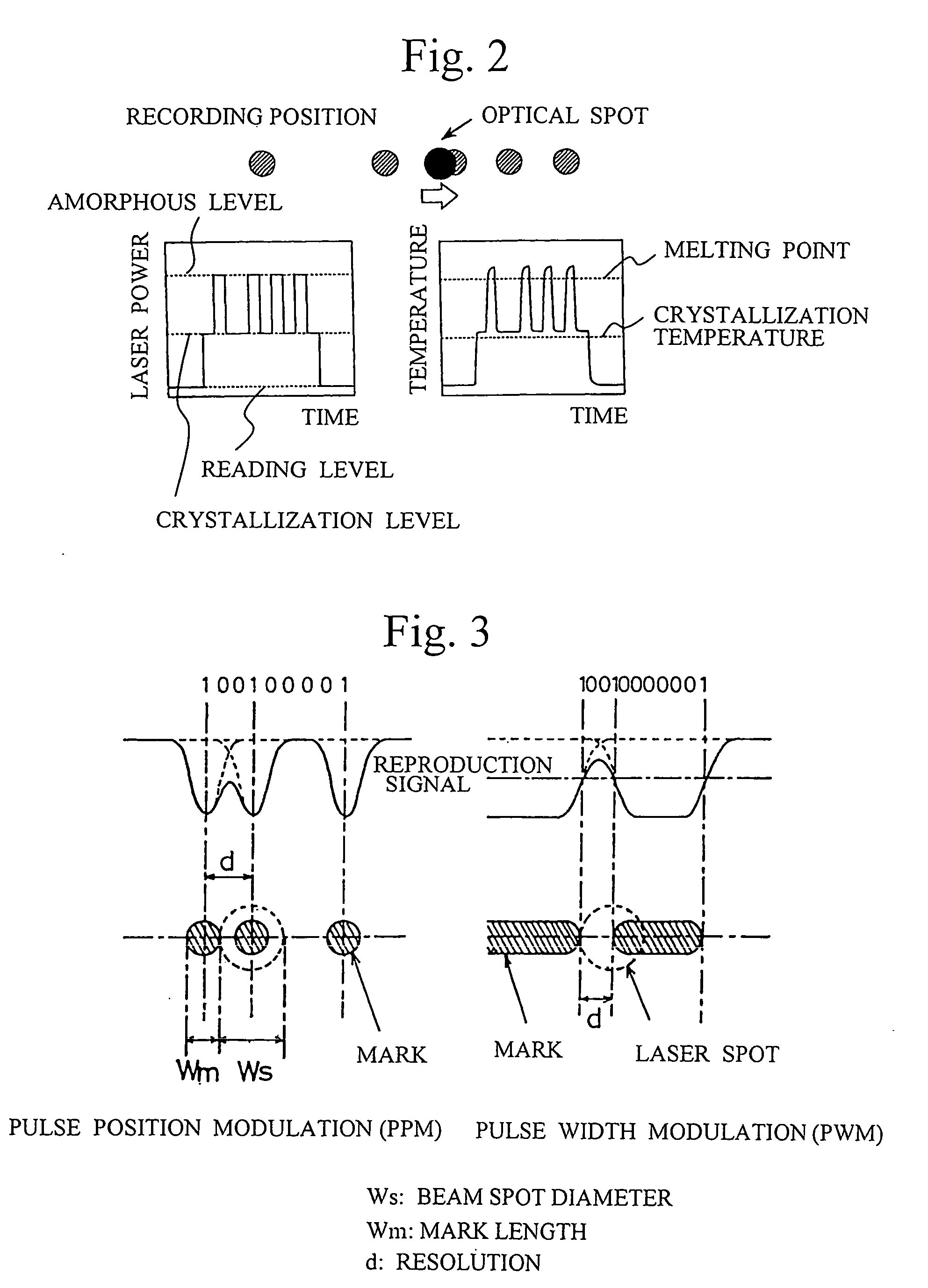Information recording medium
a technology of information recording and information, applied in the field of information recording media, can solve the problems of increasing material cost, mass production suffers, and the address data cannot be read in the preformat portion, and achieves the effects of reducing thickness, narrowing of track pitch, and reducing stress
- Summary
- Abstract
- Description
- Claims
- Application Information
AI Technical Summary
Benefits of technology
Problems solved by technology
Method used
Image
Examples
embodiment 1
(Structure and Process of Manufacturing the Information Recoding Medium of the Invention)
FIG. 1 is a cross section of the disc information recording medium according to a first embodiment of the invention, which was manufactured by the following process.
First, a first protective layer 2 comprising (MgF2)50(ZnS)50 was formed on a polycarbonate substrate 1 of a diameter 12 cm and a thickness 0.6 mm, to a film thickness of 30 nm. The substrate 1 was provided on the surface thereof tracking grooves of a track pitch of 0.615 microns for land / groove recording, and with a pit sequence at a position off the track center, i.e., substantially on an extension of the boundary between land and groove, the pit sequence indicating address information or the like. Then, a lower boundary layer 3 comprising a Cr2O3 film was formed to a thickness of 2 nm, followed by the sequential formation of a recording film 4 comprising Ge38.1Sb9.5Te52.4, a second protective layer 5 with a thickness of 8 nm an...
embodiment 2
A disc (Embodiment 2) was prepared that differed from the disc of Embodiment 1 only in the first protective layer, and the number of overwrites was measured in the same manner as in the case of Embodiment 1. The result showed that the number of overwrites can be increased even when the thickness of the disc is smaller than that of Embodiment 1.
In the first protective layer of Embodiment 2, a first protective layer 2 made of (MgO)60(SnO2)40 was formed to a thickness of 30 nm.
(Composition and Film Thickness of the First Protective Layer)
The change in reflectivity was determined after rewrites of 10000 times while changing the mole ratios of MgO and SnO2 in the material of the first protective layer. As the film formation rate changes depending on the amount of MgF2, the ratio to (ZnS)80(SiO2)20 was determined. The results are shown in Table 6.
TABLE 6MgO contentChange in(mole %)reflectivity (mV)Film formation rate6202.510102.01581.72561.54031.26021.07510.99000.710000.2
The res...
embodiment 3
(COMPARATIVE EXAMPLE 1)
A disc (Comparative Example 1) was prepared that was identical to Embodiment 1 except that the first protective layer and the recording film were changed.
The first protective layer consisted of a (ZnS)80 (SiO2)20 film to a thickness of 130 nm. The recording film consisted of a Ge22Sb22Te56 film to a thickness of 8 nm. When the material cost for the first protective layer was compared in the same manner as in Embodiment 1, the result showed that the material cost was more than twice as much as that of Embodiment 1, as shown in FIG. 10.
PUM
| Property | Measurement | Unit |
|---|---|---|
| thickness | aaaaa | aaaaa |
| thickness | aaaaa | aaaaa |
| thickness | aaaaa | aaaaa |
Abstract
Description
Claims
Application Information
 Login to View More
Login to View More - R&D
- Intellectual Property
- Life Sciences
- Materials
- Tech Scout
- Unparalleled Data Quality
- Higher Quality Content
- 60% Fewer Hallucinations
Browse by: Latest US Patents, China's latest patents, Technical Efficacy Thesaurus, Application Domain, Technology Topic, Popular Technical Reports.
© 2025 PatSnap. All rights reserved.Legal|Privacy policy|Modern Slavery Act Transparency Statement|Sitemap|About US| Contact US: help@patsnap.com



